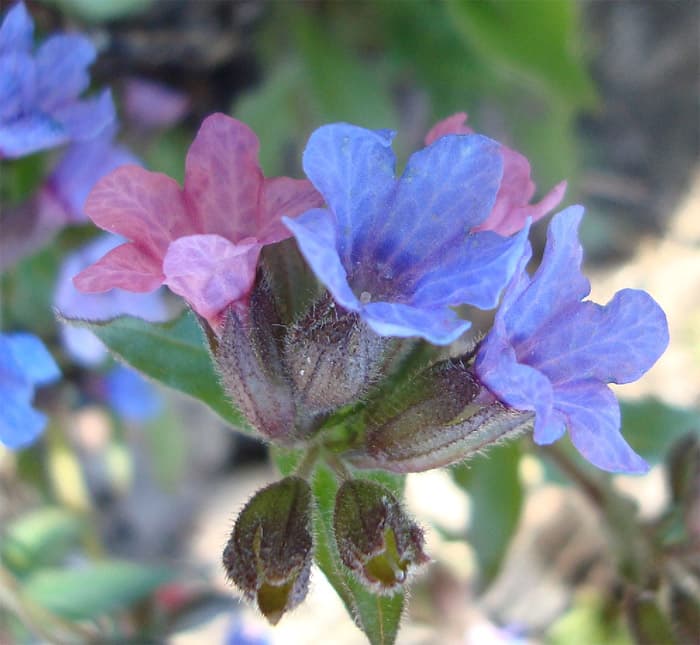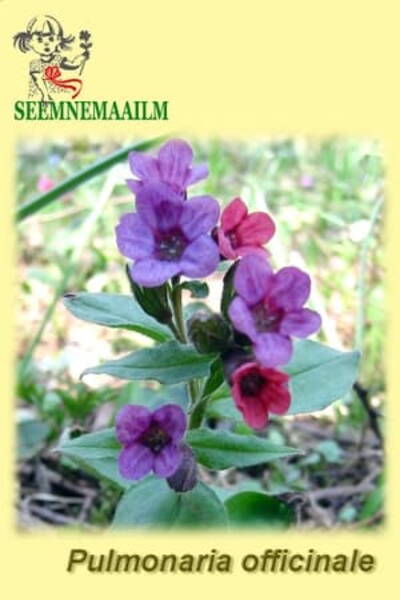It grows everywhere from Western Europe to Siberia in deciduous forests on humus-rich soils.
Perennial herbaceous plant up to 10-30 cm tall, with a black branched rhizome. The stems at the top are bristly, with glands. The corolla is funnel-shaped with five bent petals, first red, then becoming purple, up to 1.5 cm in diameter. It blooms in early May and blooms for 25-30 days. Winter-hardy down to -35 °C. (Z4 - Z8). In culture since the 16th century.
Reproduction: by dividing the bush and seeds. 1,0 g = 100-120 seeds.
The soft lungwort reproduces especially well from freshly collected seeds. Seedlings dive at a distance of 5-8 cm from each other. Lungworts are propagated by dividing the bush (lungwort long-leaved, lungwort sugar, lungwort soft and interspecific hybrids) and rhizome segments (lungwort red, lungwort officinalis, lungwort shaft-shaped and lungwort angustifolia).
It is best to divide the plant and plant in July-August, after flowering, the death of old leaves and the formation of new rosettes. Planting is carried out to a depth of 2-4 cm, planted at a distance of 15-20 cm. When planting, the roots are shortened. The ground around the planted plants is mulched with humus, and to reduce moisture evaporation, they are covered with non-woven material for several days.
Location: in a semi-shaded or shaded, cool place. The plant does not tolerate heat and is relatively moisture-loving.
Soil: prefer sandy loam or loamy, alkaline or slightly acidic, loose soil containing humus.
Diseases and pests: In cold, wet years, red lungwort is damaged by powdery mildew.
Use: in groups, mixborders and rocky areas. The leaves do not lose their decorative properties for a long time, which makes them valuable for borders.
Lungworts are undeservedly rarely grown in gardens, although these bright, early-flowering plants with beautiful foliage that create a decorative cover should find their place in the garden...
Red lungwort and angustifolia lungwort can be recommended as ground cover plants for shaded areas, and soft lungwort will decorate flower beds both in the shade and in more open areas of the garden.
Partners: look good with ferns and shrubs.
Care: water in dry weather. Add humus regularly. During the season, feed once in mid-summer, during the period of intensive growth of new leaves, with a solution of complete mineral fertilizer (15-20 g per 10 l), spending this amount per 1 m2. If necessary, cut off overgrown shoots with a shovel. Before winter, it is advisable to mulch with peat.
Water the lungwort generously in dry weather, mulch the soil with peat or humus, and remove old leaves that have lost their decorative properties. After the last flower has faded, cut off the peduncle without leaving a stump: a plant that stops worrying about producing seeds has more energy left to maintain a brighter and healthier appearance.

Lungwort can grow in one place for many years, but its leaves become smaller over the years, so it is better to divide the bushes after five years. In Estonia, lungwort overwinters well without shelter, although young seedlings or first-year plantings, especially those made at the end of the season, will be more reliably covered with peat, dry leaves or spruce branches for the winter. Since lungwort is a primrose, the shelter is removed in early spring.
To the listed advantages of the plant, add its unpretentiousness and attractiveness to bees (if the bee family is strong and the weather is good, then it can gain five kilograms of excellent aromatic honey in one “shift” in the forest medunic glades).
But the fly in the ointment, which somewhat spoils the taste you get from the merits of lungwort, will be its frequent defeat by powdery mildew. In addition, slugs love to feast on young leaves.
In the garden, lungwort is used mainly as a ground cover plant, suitable for moist, shaded corners. Its usual place is among bushes or grass, under trees, in the foreground of shady borders in the flower vicinity of primroses, geraniums, hoofweeds, mountain weeds, hellebores, hostas and especially ferns.
The Latin name for the lungwort is “pulmonaria” which translates as “knowing the lung” (“pulmo” - lung). According to the doctrine of the signatures of Paracelsus (“Nature shows by the general appearance of the plant what it can serve to treat”), the lungwort leaf, when looked at closely, resembles a lung.
The juice from its leaves was used in folk medicine in the treatment of pulmonary diseases, but it has been used not so long ago. It is not found in the classical herbal books of the Ancient World, but medieval authors already mention lungwort.
Modern official medicine also does not find any particularly valuable substances in lungwort and practically does not use it.
Traditional herbalists are not so categorical and often recommend drinking lungwort tea for sore throat, hoarseness, cough, mucus in the throat, dysentery, and also for bladder diseases. But one thing can be said firmly: such tea will not harm anyone, there are no contraindications to its use.
Interestingly, in England lungwort is grown specifically as a salad plant. Its young, sour and sharp-tasting leaves, rich in ascorbic acid and other vitamins, give salads a vermouth-like flavour.
Lungwort is one of the few plants that retain vitamin C when dried, salted and pickled. By the way, in a garden where you know the location of all the plants, you can try to get the green vitamin-rich leaves of lungwort even from under the snow.
.jpg)
Common lungwort, bloody butcher, boys and girls, hundreds and thousands, Jerusalem cowslip, Jerusalem-sage, Joseph and Mary, spotted dog.















